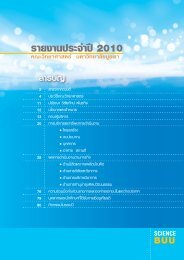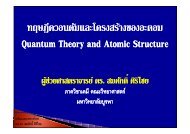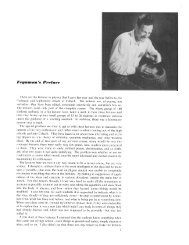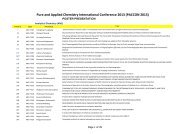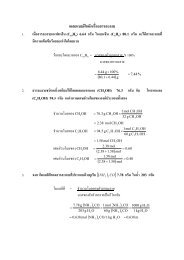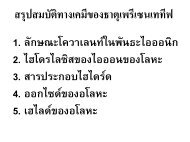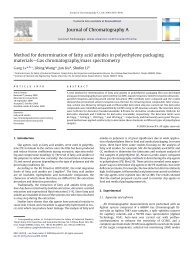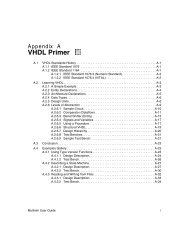USER MANUAL SWAN Cycle III version 40.72A
USER MANUAL SWAN Cycle III version 40.72A
USER MANUAL SWAN Cycle III version 40.72A
Create successful ePaper yourself
Turn your PDF publications into a flip-book with our unique Google optimized e-Paper software.
4 Chapter 2<br />
can be used for nested computations but the boundaries should always be rectangular.<br />
The use of unstructured grids in <strong>SWAN</strong> offers a good alternative to nested models not<br />
only because of the ease of optimal adaption of mesh resolution but also the modest effort<br />
needed to generate grids about complicated geometries, e.g. islands and irregular shorelines.<br />
This type of flexible meshes is particularly useful in coastal regions where the water<br />
depth varies greatly. As a result, this variable spatial meshing gives the highest resolution<br />
where it is most needed. The use of unstructured grids facilitates to resolve the model area<br />
with a relative high accuracy but with a much fewer grid points than with regular grids.<br />
It must be pointed out that the application of <strong>SWAN</strong> on ocean scales is not recommended<br />
from an efficiency point of view. The WAM model and the WAVEWATCH <strong>III</strong> model,<br />
which have been designed specifically for ocean applications, are probably one order of<br />
magnitude more efficient than <strong>SWAN</strong>. <strong>SWAN</strong> can be run on large scales (much larger than<br />
coastal scales) but this option is mainly intended for the transition from ocean scales to<br />
coastal scales (transitions where nonstationarity is an issue and spherical coordinates are<br />
convenient for nesting).<br />
A general suggestion is: start simple. <strong>SWAN</strong> helps in this with default options. Furthermore,<br />
suggestions are given that should help the user to choose among the many options<br />
conditions and in which mode to run <strong>SWAN</strong> (first-, second- or third-generation mode,<br />
stationary or nonstationary and 1D or 2D).<br />
2.2 Limitations<br />
The DIA approximation for the quadruplet wave-wave interactions depends on the<br />
width of the directional distribution of the wave spectrum. It seems to work reasonably<br />
in many cases but it is a poor approximation for long-crested waves (narrow directional<br />
distribution). It also depends on the frequency resolution. It seems to work reasonably in<br />
many cases but it is a poor approximation for frequency resolutions with ratios very different<br />
from 10% (see command CGRID). This is a fundamental problem that <strong>SWAN</strong> shares<br />
with other third-generation wave models such as WAM and WAVEWATCH <strong>III</strong>.<br />
The LTA approximation for the triad wave-wave interactions depends on the width<br />
of the directional distribution of the wave spectrum. The present tuning in <strong>SWAN</strong> (the<br />
default settings, see command TRIAD) seems to work reasonably in many cases but it has<br />
been obtained from observations in a narrow wave flume (long-crested waves).<br />
As an option <strong>SWAN</strong> computes wave-induced set-up. In 1D cases the computations are<br />
based on exact equations. In 2D cases, the computations are based on approximate equations.<br />
This approximation in <strong>SWAN</strong> can only be applied to open coast (unlimited supply<br />
of water from outside the domain, e.g. nearshore coasts and estuaries) in contrast to closed<br />
basin, e.g. lakes, where this option should not be used. The effects of wave-induced cur-





